
|   |

|   |
|
A palette of variegated expressions - Satish Suri e-mail: satishism@yahoo.co.in Pics: Sreenath Narayan September 24, 2019 In its first foray into Bangalore, Navaneetham Cultural Trust having an established presence in Kerala and Mumbai, presented three young artistes. Paridhi Joshi in her Odissi performance began with a mangalacharan "Dyayeth suvarna varna" in praise of goddess Durga, encapsulating the various attributes of the goddess, her beauty and radiance, the strength of her power when she slays the demon Mahishasura and one who represents the five elements of the universe. It was set to the music of Pt Gopal Chandra Panda and choreography of Guru Gangadhar Pradhan and Aruna Mohanty. She followed it with an ashtapadhi "Dhira samire" which describes Radha who is angry as Krishna is enjoying affectionate exchanges with other gopis and is not acknowledging her presence. Radha's sakhi informs Krishna of Radha's condition. As Krishna hears the moving account of Radha's pitiful condition, he asks the sakhi to go to Radha, pacify her with his humble appeal and bring her to him.The sakhi entreats Radha to go to the bower. 'Leave your anklets. These are your enemies, they make a loud noise when you walk, and shake when you enjoy the union. Put on this black garment as you go out in the dark night.' Music composition is by Bijay Kumar Jena and choreography by Madhulita Mohapatra. Paridhi concluded with Ardhanareeswara, the divine merging of supreme consciousness (Shiva) and divine energy (Shakti). Both immanent and transcendent, it represents the self-effulgent union of universal contrasts, symbolising harmony and balance of the whole universe and all levels and stages of life. This eternal union of Shiva and Parvati, known as Purusha and Prakriti, representing the male and female halves transcends the distinction of male and female gender. Life co-exists with death; Parvati is the creative force whereas Shiva is the destroyer. She is the mother of the three worlds and he is the father. Together they represent the completeness of the universe and relieve the world from burdens. Ardhanareeswara Stotram by Adi Shankaracharya had music by Pt.Raghunath Panigrahi set to Ragamalika and Talamalika. The original choreography is by Guru Kelucharan Mohapatra. Paridhi's performance provided a visual delight, manifesting the tandava and lasya aspects, with bhangis, mudras and statuesque poses highlighting the choreography with an emphasis on rhythm and sensitive abhinaya and flair of pure dancing. Adding verve to her performance was her attractive stage presence and dignified grace.  Paridhi Joshi  Gururaju  Mrudhula Bhasker The Kshetrayya padam "Entha chakkani vadu na sami" on the sringara rasa describing Gopala and all his intrinsic beauty gave the artiste an opportunity to showcase his histrionic ability, manifesting the rasa in abundant measure. He concluded with a Shiva stuti, describing the lord of dance, Nataraja, dancing to the accompaniment of Saraswathi playing the veena, Indira playing the flute, Lakshmi singing in her golden voice,Vishnu playing the mridangam and Brahma playing the cymbals.The piece was executed with flourish, virtuosity and sparkled with vibrant footwork. Mrudhula Bhasker, a disciple of Sathyanarayana Raju, presented a set of traditional items of the Bharatanatyam repertoire. Her Pushpanjali in Gambheeranattai showcased the attributes of the elephant-headed god, the remover of obstacles and how he rose to become the Adi Deivam. The composition provided for a bright and sprightly execution by the artiste. Moving on to a padam, a composition of Papanasam Sivan which showcases the Navarasas based on the many instances in the life of Lord Shiva, she captured the various nuances skilfully. She concluded her performance with a Devarnama "Baaro Krishnayya" about how Udupi Krishna turned around to give darshan to Kanakadasa and answered his prayers. Mrudhula showcased the dominant bhakti rasa in the composition. Navaayanam: Colourful vignettes Pics: Joseph Santhosh Kumar and SatyanarayanaY.C 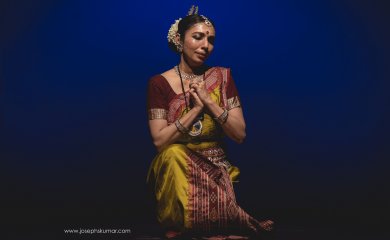 Sharmila Mukerjee 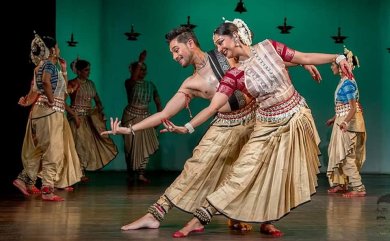 Sanjali Dance Ensemble 'Navaayanam' presented by Sanjali Centre for Odissi Dance in honour of the late Sanjukta Panigrahi embodied high calibre performances by the artists. Sharmila Mukerjee of Sanjali Centre inaugurated with a traditional mangalacharan and followed it with a Shiva stuti. Charming expressions and arresting movements characterised her presentation, proving her command over the idiom. The choreography by Sanjukta Panigrahi and music composition by Pt Raghunath Panigrahi enriched the rendition. She concluded with a Trikhandi pranam. The highlight of her performance was the rendition of the Devarnama "Saddu madalu beda" in raag Behag which was both innovative and inspiring. The exemplary music composition of Praveen D Rao synergised to the Odissi format of rhythm made it a hallmark presentation beyond the Odissi repertoire. The nayika pleads with Lord Krishna who has arrived at the door not to make noise and disturb as everyone in the house has retired for the night. The composition was embellished by soulful singing of Varijashree Venugopal and Sharmila's choreography was executed with a depth of intensity uplifting the item to an artistic experience. The Sanjali Dance Ensemble presented 'Shishira Geetham' capturing the glory and moods of the winter season as described by Kalidasa in Ritu Samhara. Fields filled with paddy and sugarcane, the freshness of nature, birds calling, add to the joy of the season. Cupid plays an active part. Happiness abounds in plenty; the women dressed in their finery are seated in their homes. It's the season for lovers and pain for those separated from their loved ones. A joyful demeanour pervaded the dancers comprising of Surajit Som, Preeti Bannerjee, Suranjana Endow, Anushree Padmanabha, Swetha Sridharan, Srijitha Sanyal, Swati Panda and Kanika Mitra Bhattacharya. In the visually rich frames highlighted by the chauka and tribhangi, the dancers created fluid lyrical motions and aesthetic impressions which was a treat for the art lovers present. The credit for the lyrics goes to Pt.Nityananda Mishra. 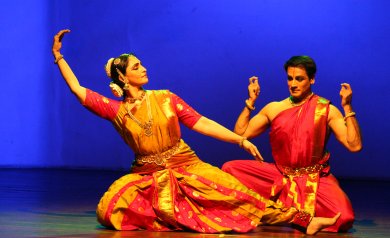 Soundarya Igoor and Sathyanarayana Raju The finale was an exhilarating show of artistry by Soundarya Igoor and Sathyanarayana Raju. After an opening invocatory number "Gambhira gana nayakam" addressed to Lord Ganesha that provided a colourful opening marked by brisk and graceful movements, the duo moved on to explore the central piece, the varnam "Sarasija nabha" in ata talam and Khamboji raga. The varnam came to life in the choreography of late Guru Narmada keeping space for improvisation creating a synchronised mosaic of movements with telling effect. The nayika implores Lord Padmanabha to show mercy and compassion on her. The opening spectacle of a frieze with the regal and stately Soundarya taking the role of Vishnu and the coy and demure Sathyanarayana Raju taking the role of Lakshmi qualified the high calibre of their artistry and command over the medium. Sathyanarayana Raju, with his impressive ability to capture the moods and attributes of both male and female and Soundarya with her fine sense of aesthetic adaptation complemented each other with delightful synchronisation and strong technique that invested every sequence with intensity with the duo displaying a variety of aesthetic sculptural poses.The switch of gender in the accompanying passages was subtle and added colourful vignettes to their presentation. The sancharis were creatively crafted to give depth to their delineation. Gajendra Moksham, the prayer of Draupadi reflected in the verse "Idhi nyaayamo idhi dharmamo?" to Krishna to save her honour, the Dasavataras, Rama breaking Shiva's bow to win the hand of Sita, redeeming Ahalya and Sabari Moksham were strengthened by exciting intensity. The lilting jathis, the different layers of expression executed with vivid abhinaya, and an excellent understanding of laya, bore testimony to the innate talent of the artists and drew a standing ovation from the appreciative audience. The final frieze of the performance was the defining moment where the dancers seemed to have transcended the barrier of gender. The aural landscape with Srivatsa (vocals), Prasanna Kumar (nattuvangam), Lingaruju (mridangam) and Raghundandan (flute) enriched the proceedings adding sensitivity and bhava to the presentation. Homage to Sister Nivedita Pics: Krishnamurthy Homage to Sister Nivedita, an ardent disciple of Swami Vivekananda curated by Dr.Padmaja Suresh of Atmalaya and presented in association with I.C.C.R and NGMA showcased specially composed dance performances. The inaugural presentation was by Soundarya Igoor who opened with the traditional homage to Lord Ganesha, "Gambhira gana nayakam" depicting the attributes of the lord with beauty and vibrancy. The interpretation of the exemplary composition"Jana samanatha jana sammodita, mana prabhasita Devi" scripted by Srivatsa in Kannada, was a hallmark presentation of classicism. The many facets of Sister Nivedita, her intense devotion to Swami Vivekananda, her compassion for the downtrodden and upliftment of the underprivileged and ideals of service to mankind were encapsulated in the rendition with artistic clarity in the Bharatanatyam format. Interesting use of a jathi in the presentation provided a colourful interpretation. With live music support with Srivatsa on the vocals and nattuvangam, Karthik Sattavalli on flute added flair to the presentation. 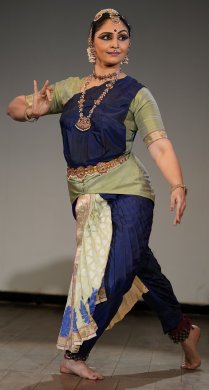 Soundarya Igoor 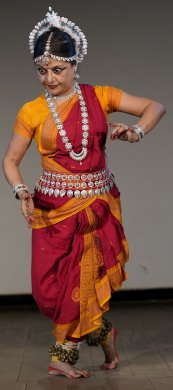 Monalisa Ghosh 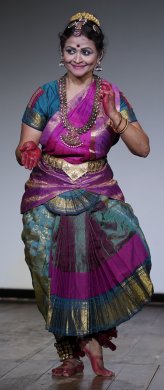 Padmaja Suresh Dr. Padmaja Suresh began with the varnam "Devar munivar thozhum paadam", a composition of Lalgudi Jayaraman dedicated to Lord Krishna. The portrayal was punctuated with expressive anecdotes of Bhrighu, Sudama and Krishna, Vamana and Mahabali.The narrative stood out for its impeccable execution of the jathis and the interesting teermanams. She concluded with the Subramanya Bharathi composition "Bhooloka Kumari" which eulogised the work of Sister Nivedita and Bharathi wrote many books about her inspired by her work and dedication to the cause of the freedom of humanity. The portrayal was profound and impactful. The Atmalaya Awards were given away by Dr.Parul Shah and Vasantha Madhavi who were the guests of honour. The Chakyar Rajan Award was given to Parameshwar Marar (percussion), the Justice Jagannatha Shetty and Smt Shanta Award to Yendamuri Subba Rao of the Kalavanthula community, and the Jayalaksmi Award to Kotapalli Ratnam of the Kalavantula community. Bangalore based Satish Suri is an avid dance rasika besides being a life member of the Music and Arts Society. |